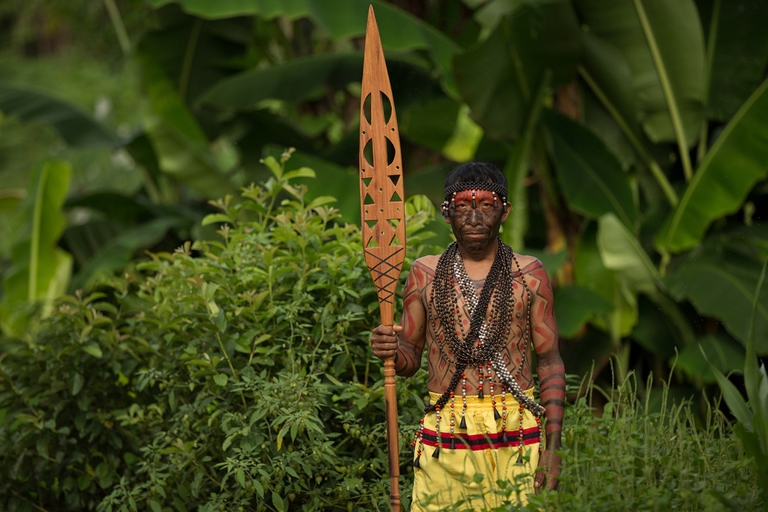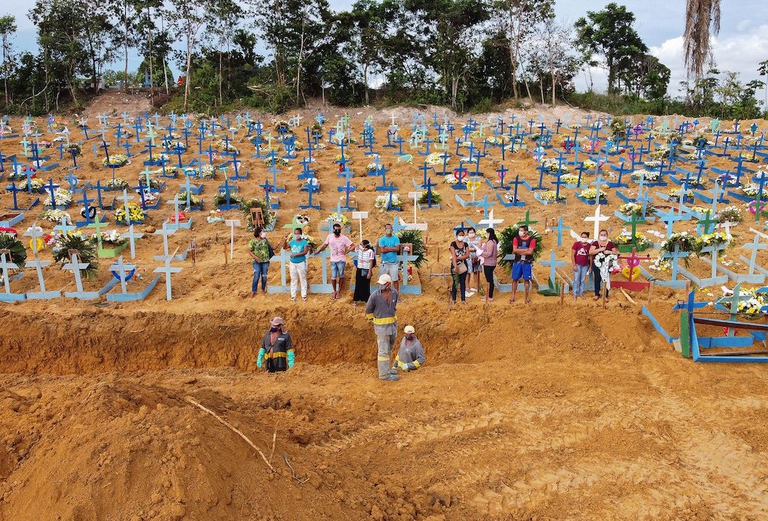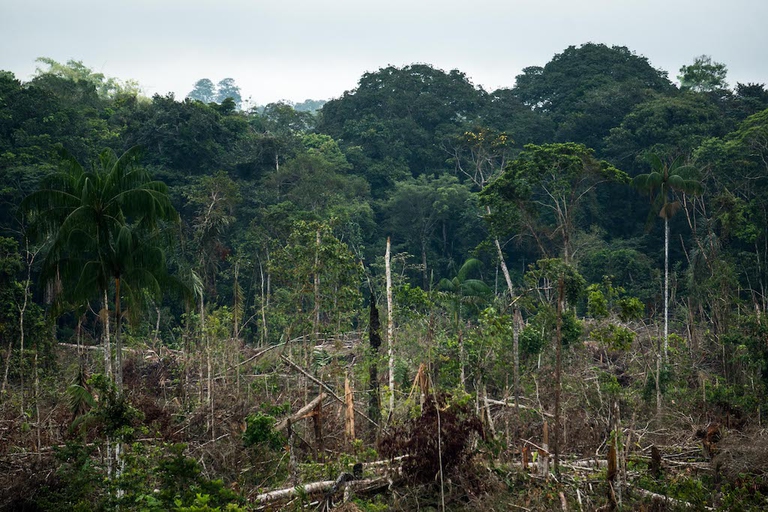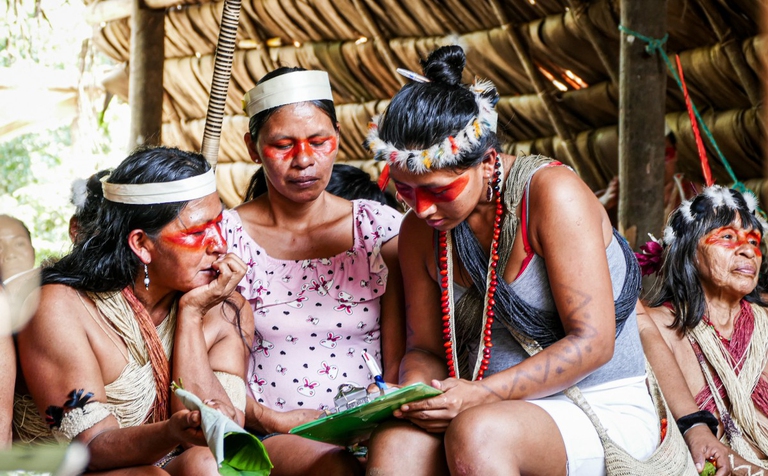
The second wave of the Covid-19 pandemic has shone a painful spotlight on the dire conditions of tea garden workers struggling against poverty in India.
Indigenous peoples in the isolated region are suffering from poor access to health, with several cities becoming hotspots of coronavirus in the Amazon. Indigenous leaders, health experts and NGOs are calling for international help.
Imagine living in a small community deep in the Amazon. You might have a wooden house with a single room. Or you might live in a maloca, as the indigenous Colombias call large community buildings where many families live together. You most probably have no more than a simple health post in your community, maybe not even that and, if present, only the most basic medicines are sold there. Getting to the nearest hospital might mean sailing across the river for eight hours, or maybe a few days.
Now imagine all this – but in the midst of the coronavirus pandemic.
“The Amazon is in the midst of an emergency,” states Gregorio Díaz Mirabal, president of COICA, the Coordinator of the Indigenous Organisations of the Amazon Basin, representing the more than three million native inhabitants living in the nine countries that share this territory. According to the organisation, over 40,500 coronavirus cases have been recorded in the region, as well as at least 2,500 deaths. “We ask for international help. If we keep on waiting for governments, our people will continue dying. And we don’t want to go extinct,” Díaz Mirabal said during the virtual launch of the Amazon Emergency Fund, attended by several indigenous leaders. The Zoom wallpaper features ethnic headgear to represent the different communities.
The emergency fund was established by COICA as well as national indigenous organisations and at least 19 NGOs including Amazon Watch, Rainforest Foundation US, Amazon Frontlines and the Rainforest Action Network. The goal is to raise at least three million US dollars in two weeks, and the overall goal is of five million. The money collected will be used to buy and distribute essential goods such as food, personal protective equipment and medicine among indigenous communities.
“We cannot wait any longer for our governments … We are in danger of extinction,” said José Gregorio Diaz Mirabal, general coordinator of COICA and a member of the Wakuenai Kurripaco people of Venezuela. #AmazonEmergencyFund https://t.co/e0wIirFX0j
— Amazon Watch (@amazonwatch) May 7, 2020
The biggest city in the Amazon, Manaus in Brazil has made international headlines for the high number of infections and Covid-related deaths. It’s been compared to Guayaquil in Ecuador, which has been singled out as perhaps the hardest hit area in the whole of Latin America. The first case in the region was recorded in Brazil on the 25th of February and at the moment the municipality of Manacapuru, part of the metropolitan region of Manaus, has the country’s highest concentration of Covid-19 infections and deaths as a proportion of the population.
Read more: Ecuador, coronavirus hijacks healthcare as victims are left in their homes for days
President Jair Bolsonaro has publicly neglected the crisis, a fact mentioned by several public health experts as one of the causes behind the many contagions in Manaus. “People are doing what the president says, causing more people to become infected and in the end to die,” according to Pedro Rapozo, secretary of the Brazilian Society for the Advancement of Science (SBPC), which recently requested that the federal government pay attention to the situation in the Amazon. “People are carrying on with their daily lives almost as if nothing is happening”.
“Around 10 per cent of Covid-19 deaths in Brazil are in the Amazon region. The health system has simply collapsed, as well as funeral services. And the high mortality rate reflects the inefficient health politics in the department of Amazonas. The lack of investment in health services is what we’re now seeing the result of,” Rapozo adds. Mass graves has been dug and hospitals in Manaus are struggling to cope. Plus, many people are never able to reach hospitals and simply die in their communities – and the fact that they’re not tested means they’ll probably never be counted in statistics on coronavirus casualties.
Rapozo also points out that indigenous peoples are the most vulnerable, as they have a higher incidence of other health conditions, and live far away from healthcare services and often in poverty. Even more vulnerable are those in voluntary isolation, as illnesses from the outside are a real threat to their existence. Rapozo believes it’s particularly worrying how cases in Amazonas as well as the departments of Loreto in Peru and Amazonas in Colombia have doubled in just a week. Also, considering the vastness of these territories and their very low population density, many cases will probably never be uncovered, let alone registered.
“There’s no way we can attend to the majority of the population”, says José Joaquín Carvajal Cortés, biologist and researcher at the renowned Fiocruz Amazonia institute in Manaus, considered one of the world’s main public health research institutions. “The area is almost without sanitary infrastructure and indigenous populations are more vulnerable to these kinds of respiratory illnesses. History has shown us how diseases like this can destroy entire native populations. Within a week we were out of beds in the hospitals”.
In Colombia, the virus arrived in Amazonas relatively late, on the 17th of April. “In the beginning we thought that the fact that the Amazon is naturally isolated would protect us,” explains Ángela López Urrego, a PhD candidate in Amazonian Studies in the National University of Colombia branch in Leticia, the capital of Amazonas, and part of the indigenous organisation CAPIUL. “But we were wrong, now what we’re seeing is just the opposite”.
She recalls the chaos that overcame Leticia together with the virus. “Our health system practically collapsed with the first case. There where something like five hospital beds and the health personnel wasn’t prepared for Covid-19. Not at all”. At one point, all hospital staff resigned, down to ambulance drivers, to protest the lack of equipment and facilities. After reaching an agreement with the management, they began working again. At the moment, in Amazonas the average number of Covid-19 cases as a proportion of the population is 18 times higher compared to the national average and recently there have been days in which this number has exceed that of the capital, Bogota. “We’ll be taking over here immediately,” was Health Minister Fernando Ruiz’s comment after visiting Leticia.
“We’re the capital of corruption in Colombia,” López adds. “The money that should have been spent on hospitals created none. If there’s one positive thing with regards to Covid-19 in Leticia, it’s that many pots have been uncovered. A lot of the corruption has come to the light of the day”.
“We’re not disavowing the state, we’re asking for coordination,” COICA president Díaz Mirabal pointed out during the emergency fund launch event. “In the Amazon, the state has intervened to some extent, but there have been instances of military personnel and doctors actually carrying the infection. Our help should arrive following strict prevention protocols”.
Peru has had a stronger response compared to Brazil and President Martin Vizcarra’s stance has been nothing like Bolsonaro’s. Yet Iquitos, capital of Loreto and the country’s “Amazonian capital” – as well as the largest city in the world which can’t be reached by road – is also on the list of Covid hotspots in Latin America. According to the BBC, its governor stated that the city can only cremate a maximum of four bodies per day, while the number of people dying is already higher. Basic medical supplies are lacking and hospitals have collapsed completely with the number of patients several times higher than that of beds.
Among a delegation from the municipality of Trompeteros in Loreto, just four people tested positive after having visited at least 18 indigenous communities along the Corrientes River distributing food, reported Peruvian media Servindi. On the 20th of April, this work was interrupted however when crew members presented acute symptoms. One of the participants was the mayor of the municipality.
In Ecuador the government has been too busy dealing with the extreme emergency in Guayaquil. The Inter-American Commission on Human Rights has issued a statement expressing preoccupation with regards to Covid-19 infections among the small indigenous Seikopai people in the Amazon. 15 cases have been recorded in this community and two of its elderly have died, out a total population of just 744. A worrying example of the vulnerability of indigenous peoples in the Amazon to the pandemic.
Read more: Ecuador, how indigenous communities are resisting against the pandemic
And these are far from the only cases. “I have information of cases among the Shuar and Ashuar in different departments like Pastaza and Napo”, says Roberto Narvaez, anthropologist and human rights specialist with more than twenty years of experience studying and working with indigenous communities in Ecuador. “Access to health is absent in the Amazon. The responsible authorities could be committing the crime of genocide as historically, whole indigenous populations have disappeared in these kinds of epidemics. This could lead to national and international penalties being levied against the government”, Narvaez says, expressing his worries.
Indigenous organizations had written to the head of @WHO, Tedros Ghebreyesus, asking for help and to set up an emergency fund from the threat of the coronavirus pandemic. @JoeniaWapichana@AnthonyBoadlehttps://t.co/IsNTK4y9TU
— Camila Rossi (@camila_larossi) May 5, 2020
There are many similarities throughout the Amazon region, populated by indigenous peoples with a vast array of cultural particularities. Geographically, it’s a very difficult area to control. There are many illegal activities still going on – mining, logging, coca cultivation – as well as extractive activities concerning oil and minerals. This means that those working in these activities risking bringing the virus with them from the outside. Plus, infrastructure as well as access to health, information and communication are poor, while corruption abounds. Besides the creation of the Amazon Emergency Fund, indigenous organisations in Brazil also recently called for the World Health Organisation to help in facing the crisis. “Our governments are all mired in debt”, Díaz Mirabal points out. “We need international help to meet this emergency that concerns the whole world. Because it’s about protecting the Amazon”.
Siamo anche su WhatsApp. Segui il canale ufficiale LifeGate per restare aggiornata, aggiornato sulle ultime notizie e sulle nostre attività.
![]()
Quest'opera è distribuita con Licenza Creative Commons Attribuzione - Non commerciale - Non opere derivate 4.0 Internazionale.
The second wave of the Covid-19 pandemic has shone a painful spotlight on the dire conditions of tea garden workers struggling against poverty in India.
In response to a lack of public services, organisations and individuals are helping citizens weather the devastating Covid-19 crisis in India.
A study indicates that the zoonotic origins of coronavirus may have been favoured by global warming’s impact on the conditions for bat habitats.
While Africa’s Covid-19 response has been praised by some, the pandemic has triggered the continent’s first recession in 25 years.
In Coronation, a documentary filmed by the people of Wuhan, the dissident Chinese artist documents the government’s rigid control during lockdown.
David Nabarro of the WHO analyses worldwide actions against the pandemic. Lockdowns alone aren’t a sustainable response to stopping Covid-19.
Kenya may fail to meet its target of ending female genital mutilation by 2022 as Covid-19 school closures have seen more girls undergo the illegal practice.
Helsinki Airport has begun implementing a Covid-19 test which is both noninvasive and simple. The exceptional nurses involved are dogs.
The drop in air pollution during worldwide lockdowns helped prevent thousands of premature deaths. But the situation is returning to pre-crisis levels.











